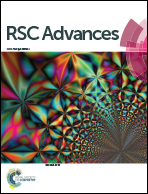Exploring the feasibility of liquid fuel synthesis from CO2 under cold plasma discharge: role of plasma discharge in binary metal oxide surface modification†
Abstract
The conversion of CO2 to CH3OH over binary mixed metal oxides of NiO–Fe2O3 is investigated in the study. A series of catalysts, i.e., NiO, Fe2O3, 5% NiO–Fe2O3 (5NF), 10% NiO–Fe2O3 (10NF), and 15% NiO–Fe2O3 (15NF), was tested for CO2 conversion and CH3OH selectivity performance. The results show that binary mixed metal oxides are more active in comparison to pure metal oxides. Moreover, increasing NiO mixing leads to the agglomeration of NiO particles. At 200 °C, around 1.5%, 2%, and 3.2% CO2 conversion is achieved for 5NF, 10NF, and 15NF, respectively. Interestingly, when cold plasma was ignited at 200 °C, around 5.4%, 6.2%, and 10.2% CO2 conversion was achieved for the 5NF, 10NF, and 15NF catalysts, respectively. 15NF exhibited the highest CO2 conversion, but produced only CH4. Plasma coupling with the catalyst led to an increase in the CH3OH yield, and around an 5.8-fold enhancement was achieved with 10NF at 200 °C compared to thermal catalysis. We showed that the combination of plasma and thermal heating brings about significant changes to the catalyst morphology, which significantly improved the catalytic activity. X-ray diffraction (XRD) and X-ray photoelectron spectroscopy (XPS) characterization revealed that plasma treatment leads to the formation of a mixture of spinel compounds (NiO–Fe2O3, NiFe2O4, and Fe3O4).



 Please wait while we load your content...
Please wait while we load your content...